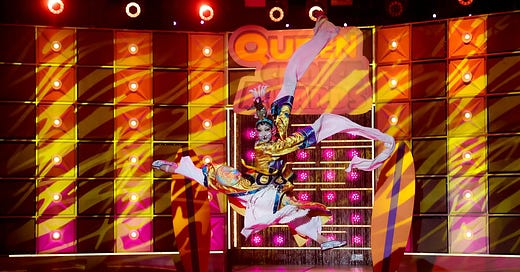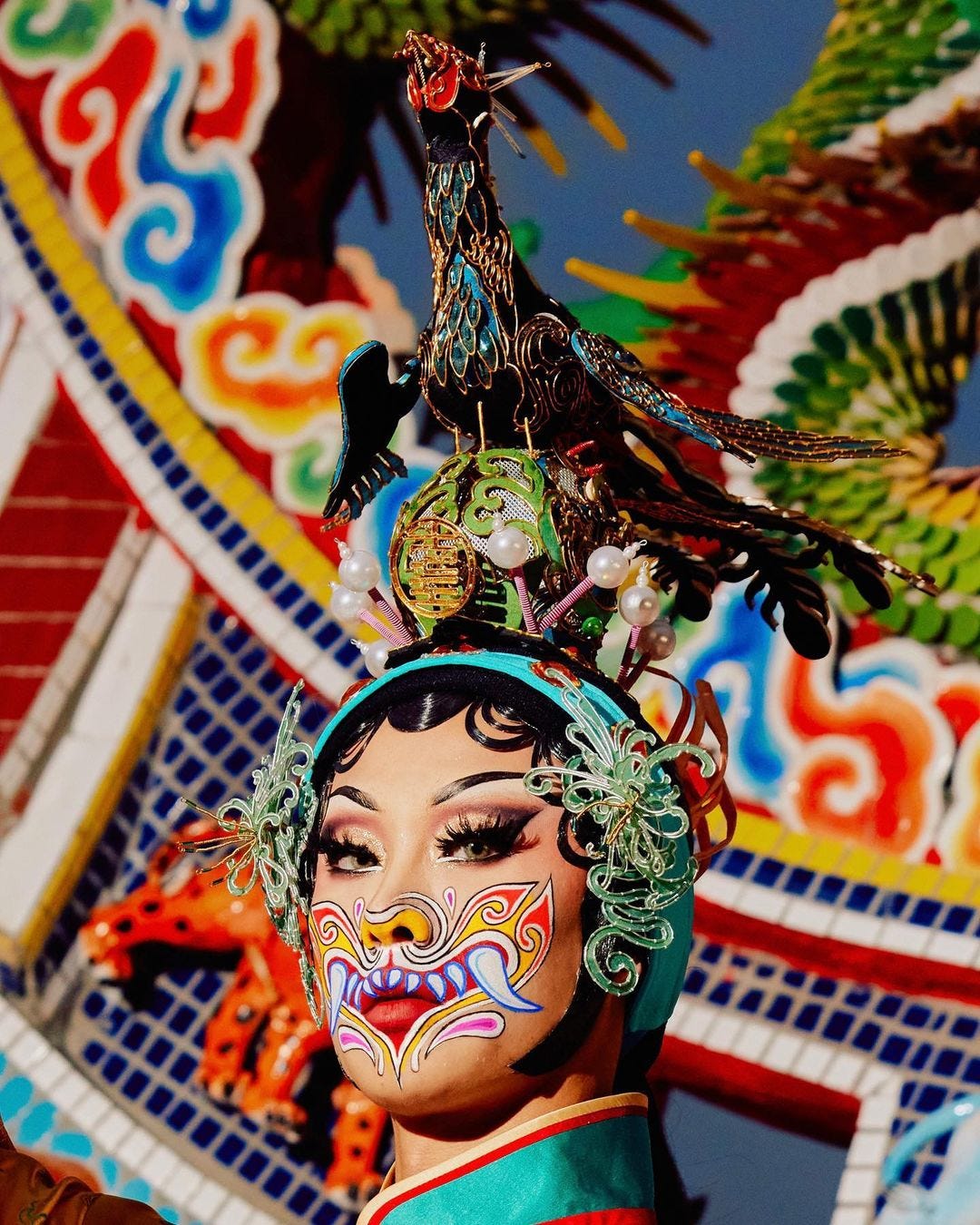Hello again, friends!
In this edition, I want to explore the art of Chinese opera costumes and makeup, especially as a tradition of cross-dressing. This spring, I spent most of my Friday nights at Boxer’s, a gay sports-styled bar in Hell’s Kitchen, to watch new episodes of RuPaul’s Drag Race season 16 as they air every week. It’s something I used to watch by myself all the time in high school, but being part of a crowd of drag race enthusiasts was a new experience I had learned to appreciate.
The winner of the season, Nymphia Wind (I hope it’s not a spoiler for anyone!), brought, arguably, one of the craziest runway package drag race had ever seen. The thing that makes her stand out is her love of yellow and her attention to detail. Every inch of her looks is well thought out, and they add up to reflect her creativity. There’s always an anticipating silence leading up to a collective gasp at the bar every time Nymphia walks the runway. Out of the 32 looks she showcased this season, the two most important ones reference the art of Chinese opera.
Chinese Opera
Traditional Chinese opera (戏曲 xìqǔ) is a form of musical theatre in China that includes various art forms such as music, song and dance, martial arts, and acrobatics. It’s a curious case of an age-old art that grew alongside the history of China that faced systematic efforts to be erased during the Cultural Revolution (1966-1976). By the Song Dynasty, the art had developed specialized roles like Dan (旦, dàn, female), Sheng (生, shēng, male), Jing (净, jìng, mighty male), and Chou (丑, chŏu, clown) were introduced into the opera. The most popular style today is the Beijing opera or Peking opera. Dialogues consist of poetic recitation and colloquial speech to differentiate a character’s age, wealth, social status, whether they’re military personnel or civilian, or even whether they’re ethnic-Han or a minority. This is comparable to Shakespeare’s use of iambic pentameter for noble characters and regular prose for the working class. These characteristic binaries also apply to other aspects like stage makeup and costumes.
Alexandra B. Bond wrote a wonderfully detailed book called Beijing Opera Costumes (2018), documenting every aspect of the visual presentation of this art form with photographic examples and the evolution of clothing in China based on time periods, region, and hierarchy. Check this book out for a better understanding and to look at the photographs of opera artists practicing their craft onstage and backstage.
Back to Nymphia Wind
The reigning drag superstar brought this first look for the introductory talent show. It’s a shiny yellow Chinese silk number with white pants, a phoenix headpiece, and water sleeves. Water sleeves (水袖 shuǐxiù) are white silk extensions attached to the cuffs of garment sleeves in Chinese opera. These are worn by both male and female characters of the upper social class to reference older emperors and court officials. The name "water sleeves" derives from the performers' ability to create movements resembling water ripples.
Nymphia’s makeup for this appearance is a peculiar combination of feminine and masculine features.
The hair illusion on her temples and forehead is common in female characters.
Her eye makeup is very normal contemporary drag makeup.
The lower half of the face is a painted mouth with exaggerated sharp teeth to represent a powerful larger-than-life presence in rough and godlike male characters, referred to as jing. However, the focal point of jing characters’ makeup is usually the top half of their face as the bottom half is often covered by a long beard.
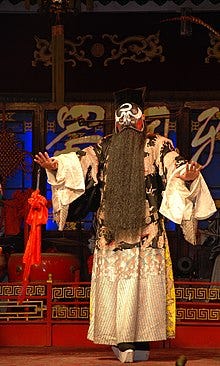
My love for hats leads diverts my eyes to that phoenix headpiece as she makes her entrance. I love how dynamic the headpiece is, bouncing with every movement. The breathtaking cultural experience of her sleeve dancing, and classical oriental string music, combined with Nymphia’s ability to make her costume work to her advantage, sets her apart from the other contestants.
Nymphia appeared as one of the top three contestants at the Lipsync LaLaPaRuZa Smackdown for the eliminated queens, originally aired on April 12, 2024. Since the top three don’t have to do much in this episode, Nymphia’s fully decked out in a purple Peking opera look featuring a large headpiece with metallic butterfly details, water sleeves, embroidery, and a corset. This specific shade of purple is so elegant, feminine, and mystical. The Western hourglass silhouette is more defined than the typical traditional blocky cuts of Hanfu garments.
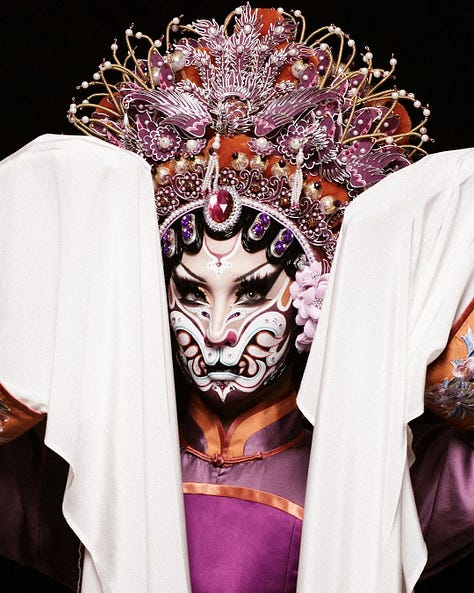
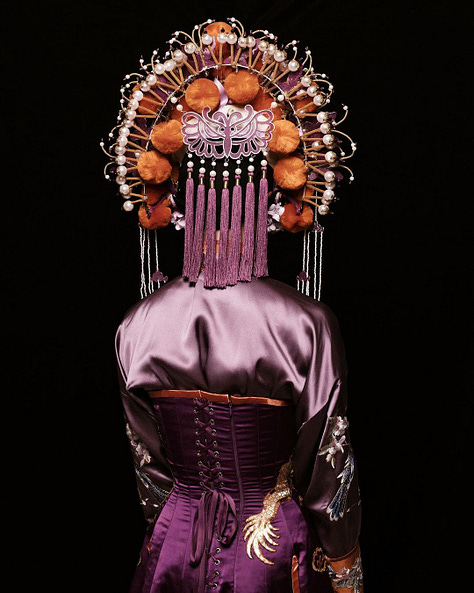
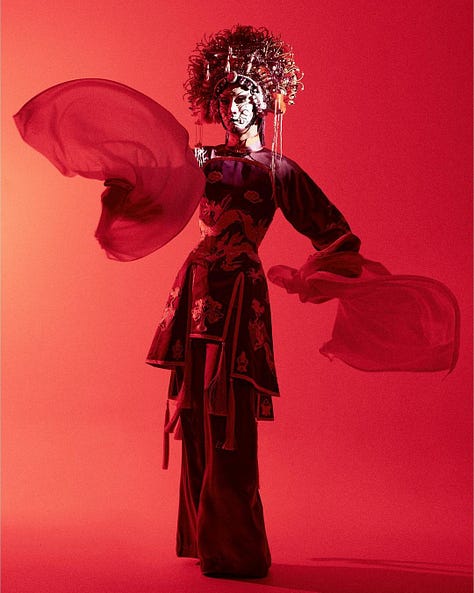
“These face paints are derived from temple fair traditions, where men draw on these face paints to embody a deity from hell that scares away evil spirits. And the attire is inspired by female characters within Peking opera. A marriage of the masculine and the feminine.” — Nymphia Wind shared on Instagram.
Cross-dressing has always been entrenched in the traditions of theater. All the female characters in Shakespearean dramas were once played by an entirely male cast. Within the writing of these plays, women characters often dress as a man to gain mobility and use their intelligence to overcome challenges, manipulating their restrictions as women in society. During the Yuan Dynasty (1272-1368), all female theater troupes prospered as they drew in a co-ed audience as opposed to the male-serving and male-dominated theater scene in Europe, a period scholars often cite as the “golden age” of Chinese theater.
“The climax of the sexually ambiguous figure of the male dan as a cultural obsession occurred in the golden age of the Beijing opera, the 1920s to the 30s.” —Cross-dressing in Chinese Opera by Siuleung Li (2003)
Male cross-dressing in Chinese opera grew in popularity as the republican era emerged before it got suppressed by the PRC’s state cultural policy. Although cross-dressing historically emerged out of restrictions, nowadays, Nymphia is only one of the many drag artists challenging binary gender norms in Asia, embracing their differences while expressing freedom and fluidity through creativity. That’s drag excellence. She’s lucky enough to operate in Taiwan in a small but flourishing community of other artists, protected in the eye of the law. Taiwan legalized same sex marriage in 2019, making it the first and only country to do so until Thailand followed their footsteps this year (2024). The bill was signed by the first woman president of the Republic of China (Taiwan), Tsai Ing-wen, who left office in May, 2024. Nymphia Wind and her drag family performed at the presidential hall to celebrate President Tsai’s successful 8 years in office.
“I wanted to meet the president in something that was representative of Taiwan, so the look is inspired by the Taiwanese yellow water lily. Like the lotus, it blooms from mud, which is a metaphor for how as a female president fighting for gay rights, going against the grain, she persisted and succeeded.”
Beyond the presidential office, Nymphia Wind and her drag family are set to represent Taiwan at the Cultural Olympiad, an artistic celebration of the Summer Olympics in Paris, in a 30-minute performance to be broadcasted internationally. So prepare to be gagged and gooped!

